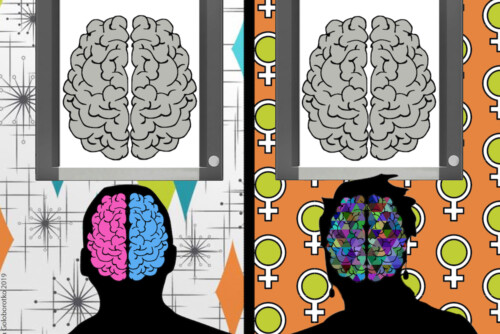In a two-part paper in this edition, Bentley et al. (2019; 2019a) consider brain plasticity as the neural embodiment of social and cultural experiences and in relation to the malleability of neural sex/gender differences – with particular reference to spatial cognition. In this short opinion piece, we raise some additional points that concern the societal context in which spatial cognition is developed and seen as a commodity.
Distinguishing between fixed ability and fluid capacity and recognizing the role of contextual factors in performance has social and ethical implications that extend beyond the laboratory. For example, gender gaps in STEM fields are often explained by reference to “natural” differences in mental rotation ability and other aspects of visuospatial cognition. Evidence of the malleability of mental rotations skills counters the claim that such differences are necessarily immutable and opens up space in which to question the structural social and symbolic inequalities that lead to gender imbalances in key cognitive skills. Cognitive differences then become a political issue that demands recognition of, and action against, unjust social structures and institutions that negatively affect performance and might result in the underrepresentation of women, nonbinary individuals, and other marginalized groups in STEM fields.
Alternatively, plasticity-based arguments may have a depoliticizing effect. If one’s mental rotation skills are understood as the outcome of individual developmental history, then improvement of spatial skills and attainment in STEM fields may come to be seen as a private responsibility. As a result, programs that aim to stimulate women’s participation in STEM fields may lose their justification. This is not an entirely unlikely scenario, since plasticity-based arguments tend to foster a neoliberal discourse that encourages individuals to engage in intensive self-management and self-optimization and that assigns the responsibility for failure, success, disease, and health to the individual rather than to the social, political or economic order (e.g., Höppner and Schmitz 2014; Pitts-Taylor 2016; Schmitz 2014, 2016). According to this discourse, one’s own brain and body should be trained, modulated, enhanced, and tuned to optimize one’s chances on the neoliberal market – apparently by autonomous, unconstrained decisions. In this discourse, plasticity of the biomaterial is a critical success factor that guides the implementation of technologies of power and the market economy into technologies of the self. The brain-training industry, for example, uses plasticity-based (pseudo-)neuroscientific rationales to compel consumers to pursue lifestyles that revolve around neoliberal values such as flexibility, ceaseless production, and competition. The inherent message of this industry – “your brain is what you do with it, make the best of it!” – overlooks two obvious yet crucial facts: first, that our chances and choices are constrained by our circumstances; and second, that we do not fully master our bodies/brains (Kleinherenbrink 2016).
This neoliberal plasticity discourse remains tied to essentialism in several, seemingly contradictory ways. As Schmitz (2012) argues, contemporary neurodiscourse is characterized by a modern neurobiological determinism that takes the brain’s materiality at a particular moment of acting as sufficient to determine, explain, and predict to the fullest extent all future processes of human thinking and acting – irrespective of its developmental history. At the same time, especially in the context of gender, the brain is often taken as biologically determined in its past, but plastically open to its future. For example, this is the case when education is tailored to “the male brain” and “the female brain” in order to optimize each individual child’s unlimited potential (Kleinherenbrink 2016). Thus, neurodeterminism and neuroplasticity are not simply opposites, but act in more complex, interrelated ways. Together, they effectively promote the idea that the brain is the key to understanding and managing ourselves.
In closing, we maintain that the brain should certainly be embraced as a valuable source of knowledge. However, in order to fully comprehend the relation between sex/gender and the brain, reflective theory has to integrate several interrelated dimensions: first, the body’s materiality that responds to experiences according to its own material principles; second, the structural inequalities, both symbolic and material, that limit, extend, and otherwise shape our experiences; and third, the individual agency with which we navigate these physical and social processes. None of these dimensions can be reduced to another, and all contribute to neurological and behavioral outcomes. By attending to the sophisticated interrelations amongst the material, the social, and the individual, we will be better positioned to produce ethically responsible knowledge.
Bibliography
Höppner, G., and S. Schmitz. 2014. “Neuroenhancement and Success: A Rendered Rereading of Popular Media.” In Gendered Neurocultures: Feminist and Queer Perspectives on Current Brain Discourses, edited by Sigrid Schmitz and Grit Höppner, 273–99. Zaglossus: Wien.
Kleinherenbrink, A.V. 2016. “The Politics of Plasticity: Sex and Gender in the 21st Century Brain.” PhD diss., Universiteit van Amsterdam, UvA-DARE http://hdl.handle.net/11245/1.542051.
Pitts-Taylor, Victoria. 2016. The Brain’s Body: Neuroscience and Corporeal Politics. Duke University Press.
Schmitz, Sigrid. 2012. “The Neurotechnological Cerebral Subject: Persistence of Implicit and Explicit Gender Norms in a Network of Change.” Neuroethics 5, no. 3: 261–74.
–. 2014. “Feminist Approaches to Neurocultures.” In Brain Theory: Essays in Critical Neurophilosophy, edited by by Charles Wolfe, 195–216. New York: Palgrave Macmillan.
–. 2016. “Materiality’s Agency in Technologized Brainbodies.” In Mattering: Feminism, Science and Materialism, edited by Victoria Pitts-Taylor, 182–203. NYU Press.



